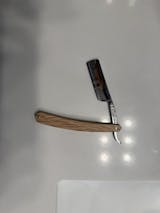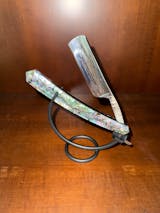Many skin experts vouch against dry shaving because it can cause irritation and razor burn. On the contrary, many still believe otherwise, gaining the same cult enthusiasm as traditional wet shavers. Arguably, dry shaving is not entirely harmful, especially when done right. And if not, you are sure to be in big trouble
So, what is dry shaving and its risks, and how do you make it work? Read on.
How To Dry Shave
Have you ever wondered if shaving without shaving cream or soap is okay? Dry shaving is a hair removal practice using a razor without using any lubricating products such as shaving cream or soap. It involves running a razor directly over dry skin to remove hair. The best razors for dry shaving are electric razors, cartridge razors, and disposable razors. These razors are designed with safety guards to minimize the risk of cuts and skin irritation by providing a barrier between the razor blades and the skin.
Check out the ways to safely shave dry:

Shaving With Electric Shaver/Razor
Electric razors are safe and effective for dry skin. It is a popular way to shave your face or your head without needing cream or soap. They have multiple blades, a built-in guard, and adjustable settings for customization.
Here's how:
- Prepare your skin: Before using the electric razor, ensure your skin is clean and dry. This step helps reduce the risk of irritation or infection during shaving.
- Shave with care: Glide the electric razor gently over your skin, and shave slowly, following the direction of hair growth. Apply light pressure and avoid going over the same area too many times to minimize the chances of irritation.
- Post-shave care: After shaving, rinse off any loose hairs and gently pat your skin dry. To keep your skin hydrated and prevent dryness or discomfort, apply a moisturizer suitable for your skin type. This will help soothe the skin and maintain its health after shaving.

Shaving With Cartridge & Disposable Razor
Cartridge and disposable razors offer a dry, close shave without water or cream due to their built-in lubricating moisture strip, making them a suitable choice for women who are dry-shaving their legs alongside a safety razor. These strips reduce friction and irritation, while flexible heads adjust to the face's contours, ensuring a smooth and comfortable shave.
Here's how:
- Prepare your skin: Clean your face with a gentle facial cleanser to remove dirt and oil. After cleansing, consider exfoliating your skin to eliminate dead skin cells that might interfere with the razor's performance.
- Hold the razor correctly: Ensure a firm grip and use light pressure. Pull your skin taut and shave following the natural direction of your facial hair growth or leg hair growth (if shaving legs) to reduce the risk of irritation and ingrown hairs.
- Keep the razor clean: After each stroke, clean it by tapping it against the sink or rinsing it under running water. This helps prevent clogging and ensures the razor glides smoothly during the shave. Once you finish shaving, wash your face and the razor to remove any remaining hair debris.
Tips On Dry Shaving
Dry shaving causes a lot of damage to your skin, whether you do it to shave your legs or face. You can avoid that by ensuring your razors are clean and working properly. Do not use a cartridge, disposable razor, or any dull razor with rusty or dirty blades when dry shaving because a dull blade can give you nicks and irritated skin.
Instead, invest in a high-quality electric, cartridge, or disposable razor with sharp blades or use a fresh razor. Additionally, moisturize your skin after dry shaving with an aftershave product to soothe any potential irritation and hydrate your skin. This will help restore moisture and prevent dryness caused by shaving.

Risks And Benefits Of Shaving Dry
Dry shaving has risks and benefits, making it essential to weigh the pros and cons before deciding if this method suits your skin and preferences.
Benefits Of Dry Shaving
When done correctly, dry shaving can offer benefits that appeal to certain individuals. Here are some of the advantages of dry shaving:
- Convenience: One of the main reasons people opt for dry shaving is its convenience. Unlike wet shaving, dry shaving doesn't require water, shaving cream, or soap. This can be particularly beneficial when you're in a rush or traveling and don't have access to running water or shaving products for a wet shave.
- Time-saving: Dry shaving can be quicker than wet shaving since you can skip the preparation steps of applying shaving cream and lathering. It can be a time-efficient option for those with busy schedules.
- Less Mess: With dry shaving, there is no need to deal with lathering and rinsing, which can lead to a more straightforward and less messy shaving experience.
Risks of Dry Shaving
Even though there are benefits to dry shaving, it is important to be aware of the possible risks. Here are some reasons why you might not want to dry shave:
- Irritation and Razor Burn: Dry shaving can be harsh on the skin, especially if not done properly. The absence of lubrication can cause friction between the razor blades and the skin, leading to irritation, redness, and razor burn.
- Increased Risk of Cuts: Dry shaving without shaving cream can increase the likelihood of cuts and nicks. The blades may not glide as smoothly over the skin, making it easier to cut yourself accidentally.
- Ingrown Hairs: Without proper lubrication and hydration, the risk of ingrown hairs may be higher after dry shaving. Ingrown hairs occur when hair curls back and grows into the skin, causing bumps and potential infections.
- Uneven Shave: Dry shaving may not provide as close or as even a shave as wet shaving, leaving some areas of the skin feeling rough or stubbly.
Before deciding whether to try dry shaving, consider whether you have normal or sensitive skin and whether you can address the potential risks with proper techniques and aftercare for your freshly-shaved skin.

Wet Vs. Dry Shaving
When choosing between dry and wet shaving, the decision ultimately depends on individual preferences and skin conditions. Dermatologists and skin experts say wet shaving is better than dry shaving due to its smoother, closer shave, reduced irritation, and exfoliation benefits. While dry shaving is convenient for specific skin types and quick touch-ups, it carries higher risks of irritation, cuts, and ingrown hairs, making it crucial to prioritize skin health and personal preferences when choosing a shaving method.
Key Takeaways
Dry shaving without lubricating products like shaving cream, shaving gel, or shave soap can lead to irritation, cuts, and ingrown hairs due to increased friction between razor blades and the skin. While convenient, it may not be suitable for sensitive skin.
For a better shaving experience, opt for wet shaving with traditional single-blade razors like a straight razor, safety razor, or shavette. These razors are easier to clean and provide a closer shave with less irritation and ingrown hairs than multi-blade razors or electric shavers. Using a single-blade razor offers better control and a more proper shave, reducing the risk of cuts and nicks during shaving, and ensuring a smoother shave.















